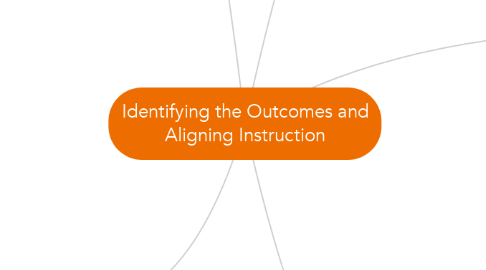
1. I. Learning Outcomes
1.1. a. One of the most critical activities in designing instruction
1.2. b. Evolve from identified goals and KASIs (knowledge, attitudes, skills, and interpersonal skills)
1.3. c. Written from the viewpoint of the learner
1.4. d. Communicate what the learner should know, feel, and/or be able to do after the learning experience
1.5. e. Should be aligned with assessments and teaching/learning strategies
2. II. Defining Outcomes and Levels of Detail
2.1. a. The refinement and continuation of the process of content analysis
2.2. b. Requires a clear picture of instructional goals, and KASIs that the learner must possess following the instruction
2.3. c. Learning theories affect learning outcomes:
2.3.1. i. Behaviorism: Emphasis on performance and competencies
2.3.2. ii. Cognitivism: Focus on the way knowledge is acquired, encoded, and retrieved
2.3.3. iii. Instructivism (Combines both):
2.3.3.1. 1. Presents clear goals and mastery-based objectives at the beginning of instruction
2.3.3.2. 2. Addresses discrete chunks of learning that represent degrees of growth in skills and thinking, then incrementally assess learners’ knowledge in each chunk
2.3.3.3. 3. Elaborates of the relevance of the outcomes to learners, making a distinction between “need-to-know” and “nice-to-know” information
2.4. d. Instructivist outcomes should always reflect what is worthwhile and measurable
2.4.1. i. Worthwhile: Relevant to learners, preparing them with a skill they can apply practically, or provide knowledge or skills relevant to acquiring other knowledge and skills
2.4.2. ii. SMART: Specific, Measurable, Action-oriented, Realistic, and Timely
2.4.3. iii. Consist of precise statements of observable competencies that learners will demonstrate after the instruction, stated in a way that indicates how the learning will be measured or assessed.
2.4.4. iv. Use action verbs to indicate these observable behaviors
2.4.5. v. Are realistic based on time and resource constraints
2.4.6. vi. Provide adequate time for completion
2.4.7. vii. ABCD: Audience, Behavior, Conditions, and Degree.
2.4.7.1. 1. A: Intended target audience is identified
2.4.7.2. 2. B: Desired behavior to be exhibited is described using action verbs to clearly communicate expectations
2.4.7.3. 3. C: Outcomes should include the conditions (resources circumstances or givens under which the behavior is to occur)
2.4.7.4. 4. D: Set clear expectations by specifying the degree or level of performance mastery expected
2.4.8. viii. While goals may be broad, outcomes can be numerous, or as many as needed to adequately address all KASIs identified.
2.4.9. ix. May use a numbering system to link goals and outcomes (Ex: 1.1, 1.2, 1.3, etc. as tied to Goal 1)
2.5. e. Constructivist and Connectivist Instructional Design:
2.5.1. i. Outcomes are often more general statements of the processes or interactions learners will experience rather than on a final product or test of knowledge
2.5.2. ii. Common goal is to foster autonomous, self-directed learners, a quality that the current times now warrant
2.5.3. iii. Rather than being tested on declarative content, learners may be assessed on the use of that content to construct a project or solve a problem
3. III. Writing Outcomes that Communicate to the Learner
3.1. a. Pros and Cons: Specific instructional objectives yield best results for intentional learning, but show a decrease in incidental learning, so in the case of learning objectives that seek to harbor exploration
3.2. b. Do not confound learning outcomes with learning activities
3.2.1. i. Objectives define competencies or capably performed skills that learners should possess after instruction
3.2.2. ii. Activities are what the instructor or instruction does, or the events that learners participate in during the learning experience
3.3. c. Consider Bloom’s Taxonomy for the movement from LOTS (Remember, Understand, Apply) to HOTS (Analyze, Evaluate, Create)
3.4. d. Effective use of HOTS (problem-solving, analyzing arguments, negotiating issues, making predictions) is dependent on LOTS
3.5. e. When a learner truly understands something, he/she can:
3.5.1. i. Explain it
3.5.2. ii. Interpret it
3.5.3. iii. Apply it
3.5.4. iv. Demonstrate perspective
3.5.5. v. Empathize
3.5.6. vi. Exhibit self-knowledge
3.6. f. Instructional designers need to understand where the learner will end up:
3.6.1. i. Identify desired results
3.6.2. ii. Determine what constitutes acceptable evidence of those results
3.6.3. iii. Plan learning experiences and instruction that are geared toward producing those results
4. IV. Aligning Outcomes to Assessments and Strategies
4.1. a. Beginning with the end in mind means developing your assessments at the same time that you develop learning outcomes
4.2. b. Outcomes and assessments will sound very similar because they are aligned, and guide the instructional designer in the selection of teaching and learning strategies that reflect the outcomes and prepare the learner for the assessments
4.3. c. Resulting instruction will:
4.3.1. i. Tell the learner what they need to know and do
4.3.2. ii. Instruct them on what they need to know and do
4.3.3. iii. Test them on what they need to know and do
5. V. Communicating Relevant Outcomes
5.1. a. Outcomes are most beneficial when the learners are aware of them, and understand how they direct the learning experience
5.2. b. Communicate relevance by:
5.2.1. i. Illustrating how concepts and skills relate to the learner’s current or future needs or goals
5.2.2. ii. Describing how the new material might relate to the learner’s past experiences or how others have used the information in their lives
5.2.3. iii. Providing guidance on how the learner can customize the experience to self-motivate
